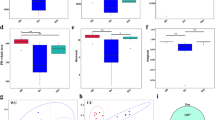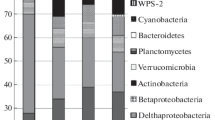Abstract
The rhizosphere of plants contains a diversity of microorganisms, some of which play an important role in the growth and development of the host plant. In this work, the diversity of fungi and bacteria associated to the rhizosphere of Tabebuia chrysantha and T. billbergii plants was analyzed. The molecular identification was performed by sequencing the ITS and 16S rDNA for fungi and bacteria, respectively. The analysis of the rDNA sequences of the rhizosphere of T. billergii showed that for domain Eukaria, the most abundant phyla were Glomeromycota (56%) and Ascomycota (39%), and for domain Bacteria, the phylum Firmicutes (19.17%) was the most abundant followed by Actinobacteria (14.90%) and Proteobacteria (8.94%). In the rhizosphere of T. chrysantha the most abundant phylum of Eukaria was Ascomycota (98%), and for Bacteria the most representative phyla were Proteobacteria (18.61%) and Actinobacteria (11.93%). A diversity of genera and species of fungi and bacteria was observed, to be more significant in T. chrysantha than T. billbergii. The taxonomic assignment of metagenomic sequences revealed a homology associated with genomic sequences of 546 bacteria and 147 fungi in T. chrysantha and 154 bacteria and 122 fungi in T. billbergii.






Similar content being viewed by others
References
Ministerio del Ambiente (MINAM) (2016) P. l. (s.f.). http://www.bosques.gob.pe/peru-pais-de-bosques. Recuperado el 10 de marzo de 2018
Che Piu H, Menton M (2013) Contexto de REDD + en Perú, Motores, actores e instituciones. Documentos Ocasionales 90, CIFOR, Indonesia
More C, Villegas P, Alzamora M (2014) Piura, Áreas prioritarias para la conservación de la biodiversidad. Lima: Naturaleza & Cultura Internacional. Naturaleza & Cultura Internacional—PROFONANPE
Rosenblueth M, Martínez-Romero E (2006) Bacterial endophytes and their interactions with hosts. Mol Plant Microbe Interact 19:827–837
Saharan B, Nehra V (2011) Plant growth promoting rhizobacteria: a critical review. Life Sci Med Res 21:1–30
Lindow SE, Brandl MT (2003) Microbiology of the phyllosphere. Appl Environ Microbiol 69:1875–1883
Berendsen RL, Pieterse CM, Bakker PA (2012) The rhizosphere microbiome and plant health. Trends Plant Sci 17(8):478–486
Rastogi G, Coaker GL, Leveau JH (2013) New insights into the structure and function of phyllosphere microbiota through high-throughput molecular approaches. FEMS Microbiol Soc 348:1–10
Schlaeppi K, Bulgarelli D (2015) The plant microbiome at work. Mol Plant Microbe Interact 28:212–217
Berlec A (2012) Novel techniques and findings in the study of plant microbiota: search for plant probiotics. Plant Sci 193–194:96–102
Santi C, Bogusz D, Franche C (2013) Biological nitrogen fixation in non-legume plants. Ann Bot 111:743–767
Wang P, Liu Y, Yin Y, Jin H, Wang S, Xu F, Geng X et al (2011) Diversity of microorganisms isolated from the soil sample surround Chroogomphus rutilus in the Beijing region. Int J Biol Sci 7:209–220
White T, Bruns T, Lee S, Taylor J (1990) Amplification and direct sequencing of fungal ribosomal RNA genes for phylogenetics. PCR protocols a guide to methods and amplifications. Academy Press, Cambridge
Krebs C (1999) Ecological methodology, 2nd edn. Cummings, Menlo Park
Miethling R, Wieland G, Backhaus BH, Tebbe CC (2000) Variation of microbial rhizosphere communities in response to crop species, soil origin, and inoculation with Sinorhizobium meliloti L33. Microb Ecol 40:43–56
Micallef S, Shiaris MP, Colón-Carmona A (2009) Influence of Arabidopsis thaliana accessions on rhizobacterial communities and natural variation in root exudates. J Exp Bot 60:1729–1742
Nguyen C (2003) Rhizodeposition of organic C by plants: mechanisms and controls. Agronomie 23:375–396
Cordero-Ramírez JD, López–Rivera R et al (2012) Microorganismos asociados a la rizósfera de jitomate en un agroecosistema del valle de Guasave, Sinaloa, México. Rev Mex Biodivers 83:712–730
Mendes R, Kruijt M et al (2011) Deciphering the rhizosphere microbiome for disease suppressive bacteria. Science 332:1097–1100
Glick B (1995) The enhancement of plant growth by free-living bacteria. Can J Microbiol 41:109
Madhaiyan M, Peng N, Te Si N, Hsin C, Lin C, Lin F, Ji L et al (2013) Improvement of plant growth and seed yield in Jatropha curcas by a novel nitrogen-fixing root associated Enterobacter species. Biotechnol Biofuels 6:140
Kumar A, Prakash A, Johri BN (2011) Bacillus as PGPR in crop ecosystem. In: Maheshwari DK (ed) Bacteria in agrobiology: crop ecosystems. Springer, Berlin, Heidelberg, pp 37–59
Hossain M, Jahan I, Akter S, Rahman N, Rahman B (2015) Isolation and identification of Azospirillum isolates from different paddy fields of North Bengal. Indian J Res Pharm Biotechnol 3:74–80
Xie C, Yokota A (2006) Sphingomonas azotifigens sp. nov., a nitrogen fixing bacterium isolated from the roots of Oryza sativa. Int J Syst Evol Microbiol 56:889–893
Zou C, Li Z, Yu D (2010) Bacillus megaterium strain XTBG34 promotes plant growth by producing 2-pentylfuran. J Microbiol. 48:460–466
Rahman A, Nahar N (2016) Complete genome sequence of Lysinibacillus sphaericus B1-CDA, a bacterium that accumulates arsenic. Genome Announc 4(1):e00999-15
Gallegos JJ, Alias-Villegas V (2014) Caracterización de una metilobacteria aislada de la superficie del grano de arroz. Libro de resúmenes de II Iberoamerican conference On Beneficial Plant-Microorganism-Environment Interactions (IBEMPA). Sesión IV-CP02. 285
Wiwattanapatapee R, Chumthong A, Pengnoo A, Kanjanamaneesathian M (2013) Preparation and evaluation of Bacillus megaterium-alginate microcapsules for control of rice sheath blight disease. World J Microbiol Biotechnol 29(8):1487–1497
Dijk VK, Nelson EB (2000) Fatty acid competition as a mechanism by which Enterobacter cloacae suppresses Pythium ultimum sporangium germination and damping-off. Appl Environ Microbiol 6:5340–5347
Fraga ME, Pereira MG, de Souza FA (2010) Micobiota do Solo de uma Área de Duna na Restinga da Marambaia. Floresta Ambient 17:1–7
Ploetz RC (2006) Fusarium wilt of banana is caused by several pathogens referred to as Fusarium oxysporum f. sp. cubense. Phytopathology 96(6):653–656
Irish BM, Goenaga R et al (2013) Evaluation of banana hybrids for tolerance to black leaf streak (Mycosphaerella fijiensis Morelet) in Puerto Rico. Crop Protection 54:229–238
Damm U, Cannon PF et al (2012) The Colletotrichum boninense species complex. Stud Mycol 73:1–36
Hatvani L, Kredics L et al (2017) First report of Trichoderma aggressivum f. aggressivum Green Mold on Agaricus bisporus in Europe. Phytopathology 101:1052
Dugan FM, Lupien SL et al (2014) Host ranges of North American isolates of Penicillium causing blue mold of bulb crops. Crop Protect 64:120–136
Hsuan HM, Salleh B, Zakaria L (2011) Molecular identification of Fusarium species in Gibberella fujikuroi species complex from rice, sugar cane and maize from Peninsular Malaysia. Int J Mol Sci 12(10):6722–6732
Huanes-Carranza J, Wilson-Krugg J (2016) Efecto de Beauveria bassiana y Metarhizium anisopliae sobre adultos y ninfas de Oligonychus sp. en condiciones de laboratorio. REBIO 36:51–58
Hoyos-Carvajal L, Chaparro P et al (2008) Evaluación de aislamientos de Trichoderma spp. contra Rhizoctonia solani y Sclerotium rolfsii bajo condiciones in vitro y de invernadero. Agron Colomb 26:451–458
Zhang S, Gan Y, Xu B (2015) Biocontrol potential of a native species of Trichoderma longibrachiatum against Meloidogyne incognita. Appl Soil Ecol 94:21–29
Bhuvaneshwari S, Velmurugan S (2013) Comparative studies for chitosan yield and chelating ability of Aspegillus niger and Rhizopus oryzae. Indian J Biotechnol 12:429–431
Soleimanian S, Abbaspour H, Mohammadi Nafchi A (2016) Contributions of arbuscular mycorrhizal fungi to growth, biomass and nutrient status of pistachio seedlings under saline conditions. J Nuts 7(1):67–74
Acknowledgements
To the National University of Tumbes, for the financing granted, through the research fund of Canon, which has made possible the realization of this study (Resolution No. 0543-2014/UNT-R), and to Inca Biotec for supporting us with the equipment and facilities.
Author information
Authors and Affiliations
Corresponding author
Additional information
Publisher's Note
Springer Nature remains neutral with regard to jurisdictional claims in published maps and institutional affiliations.
Rights and permissions
About this article
Cite this article
Llacsa, L.X., Solis-Castro, R.L., Mialhe, E. et al. Metagenomic Analysis of the Bacterial and Fungal Community Associated to the Rhizosphere of Tabebuia chrysantha and T. billbergii. Curr Microbiol 76, 1073–1080 (2019). https://doi.org/10.1007/s00284-019-01725-5
Received:
Accepted:
Published:
Issue Date:
DOI: https://doi.org/10.1007/s00284-019-01725-5




